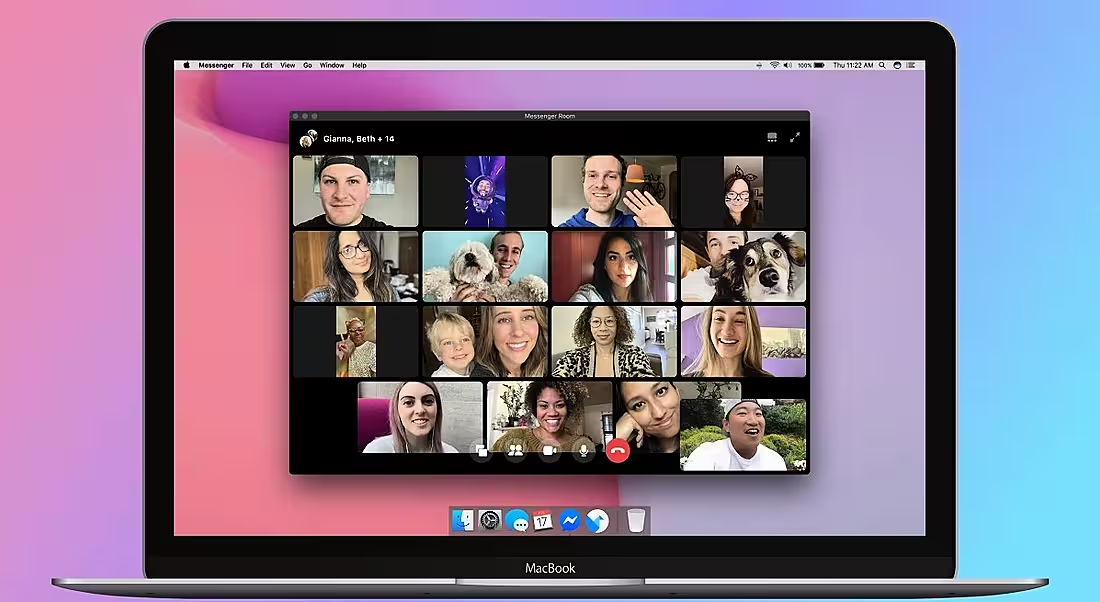Zoom may now be the most familiar name for catching up with friends virtually, but is Facebook Messenger Rooms a better option?
Zoom never set itself out to be a way for friends to catch up, but the coronavirus pandemic changed all that. As it recently showed, the number of people using the video conferencing platform has surged since this time last year, but social media mainstays are in no mood to let this last forever.
In April, Facebook launched Messenger Rooms, which can allow for up to 50 people to chat at a time over video or audio. While on the surface it doesn’t appear too different from the likes of Zoom, there are a number of factors that may make it a very appealing platform for people to socialise virtually. Here are some features and tips to get you started if you’re interested in using it.
How do you access it?
Somewhat surprisingly, you don’t actually need to have a Facebook account to access Messenger Rooms. A room needs to be set up by someone with Facebook or Messenger, but anyone with a room link sent to them can access it through a web browser without signing into an account.
As we’ve already touched on, up to 50 people can access a video room at any one time. On desktop, anyone looking to start a room can do so through their Facebook page. Near the top of the News Feed, there is a button to start a new activity in Messenger Rooms.
On mobile, your options are much greater. All of Facebook’s platforms are able to access Rooms, including Instagram and WhatsApp.
How do you set up a call?
Unlike the more formal meeting schedule that you might use to set up a Zoom call, Messenger Rooms asks you to set out an activity for the call. This can range from the default room, such Colm’s room, to a whole range of other pre-set activities such as ‘coffee chat’ and ‘keep me company’.
From there, the person setting up the room can choose a start time, but can also choose who gets to access the room. This is probably the most important setting you can have before getting started, as a few tweaks will prevent you from having dozens of uninvited guests from turning up on your call (now often referred to as ‘zoombombing’).
Messenger Rooms available through the Facebook app. Image: Facebook
This might be more possible than you’d think with Messenger Rooms as, by default, Facebook will put up an invite to the room on the news feed of all of your friends, which could lead to some awkward catch-ups with acquaintances. The safer solution is to choose the ‘specific people’ option, which lets you invite up to 50 people from your friends list. Otherwise, you can send on a link to the room that anyone – regardless of whether they have a Facebook account or not – can join.
While a similar setup can be found on the Facebook and Messenger apps on mobile, accessing it is a little less obvious on Instagram and WhatsApp. On Instagram, you’ll need to click the arrow icon at the top of your feed, and then select the video icon to access Rooms. On WhatsApp, it is accessed through the ‘calls’ section of the app, but when selected it will try take you to the Messenger app. A more detailed guide for both can be accessed here and here.
Should I use this instead of Zoom?
Just as Zoom didn’t create its video conferencing platform for socialising, Facebook Messenger Rooms probably shouldn’t be seen as an option for businesses. Not that it can’t be done, but this new platform has been built with socialising in mind.
On the surface, many things will look very similar to Zoom and other video conferencing tools. There’s a button to toggle video, audio and who you can see on screen. For the call admin, there’s a button to see who’s in the room, an option to kick people out or invite new people in, and a button to lock the room.
There’s also the option to share your screen if you’re holding a quiz, movie night or just want to show off your latest doodles.
On desktop, Messenger Rooms is probably the most similar to Zoom, with functionality trimmed back to the bare essentials. On mobile, however, it adds a number of features that distances Rooms from more business-like competitors.
Similar to apps such as Instagram or Snapchat, users can try out a bunch of filters and pre-set virtual backgrounds. It also comes with augmented reality special effects that change the lighting and allow you to put a virtual cowboy hat on your head, if that’s your thing.
It also includes some basic games that could pass the time while waiting for others to join, such as turning each person’s head into basketball net and moving your head to try and catch balls.
There are also no time limits, unlike Zoom that restricts free accounts to 40-minute sessions at a time.
Is it secure?
While Zoom is now working towards end-to-end encryption for all its users, Facebook has come straight out to say that while it promises the platform is secure, it is not fully encrypted. The Intercept has also raised questions about what data Messenger Rooms collects.
For those looking to join a room without a Facebook account, the company said in a lengthy blog post: “Across our services, we work with outside vendors that help us do things like reviewing and addressing issues reported by users and we may share information with these partners, like the name of a room and who’s in it, in order to do this work.”
This, it said, means Facebook won’t use your data to target adverts in Messenger Rooms or on its wider platforms. However, those without a Facebook account will also have metadata collected – such as the device or browser used to access a room – to help “keep it secure”.
Given these facts and that Facebook is aimed at casual users, it would not be recommended to discuss top secret information while using Messenger Rooms.






